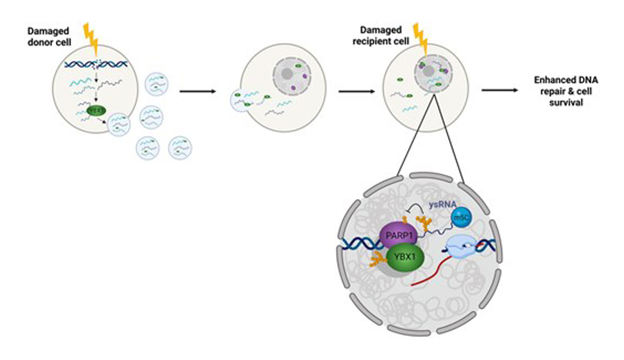Y RNA fragments help cells repair DNA damage
The DNA inside cells is susceptible to damage from endogenous and exogenous sources. This damage can potentially lead to disastrous consequences for cells and whole organisms. To prevent the buildup of mutations and the development of diseases like cancer, cells rely on the DNA damage response (DDR) – a network of pathways that detects and repairs DNA damage. Importantly, this response is not limited to individual cells. Through the release of exosomes – small, membrane-bound compartments – cells can communicate and coordinate DDR across their environment. These exosomes carry proteins and RNA, and their contents change when cells are exposed to damaging conditions such as irradiation. This allows healthy, unexposed “bystander” cells to prepare for and resist potential DNA damage.
The Gullerova lab has been investigating the lesser-known role of non-coding RNAs in the DNA damage response. In their latest study, they show that following DNA damage, the RNA-binding protein YBX1 selectively packages a specific class of non-coding RNAs – Y RNA fragments – into exosomes. These exosomes are then taken up by neighbouring cells. Once inside, the Y RNA fragments interact with YBX1 and the DNA repair protein PARP1 at the sites of DNA damage. This interaction enhances DNA repair processes and improves cell survival, demonstrating a cooperative response to DNA damage at the population level.
This exciting study demonstrates the important and underappreciated role RNA plays in coordinating DNA repair between cells, providing new insight into how organisms protect themselves from genetic instability.
Professor Gullerova explains: “This study reveals that RNA can play a critical role in sustaining DNA repair process across populations of cells. It’s a powerful example of how cells support one another in the face of damage”

In a damaged donor cell, YBX1 packages non-coding RNAs into exosomes which are taken up by healthy bystander cells, enhancing DNA repair and survival of these cells.
Written by Isabella Maudlin (Hinch lab)
Explore more
Read the Paper
Shaw, A. et al (2025), Y RNA fragments help cells repair DNA damage. Nucleic Acids Res. 6;53(11):gkaf517. doi: 10.1093/nar/gkaf517
Gullerova Group
Understanding how intronic gene silencing is de-regulated in cancer cells and how synthetic tsRNA can be used therapeutically.
RNA & Gene Expression
Several Dunn School groups use a range of molecular biology approaches to investigate the fundamental mechanisms underlying transcription, transcriptional gene silencing, and RNA processing.